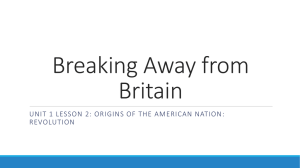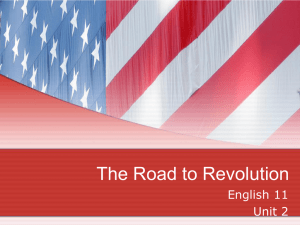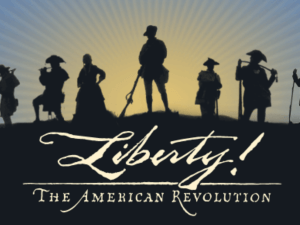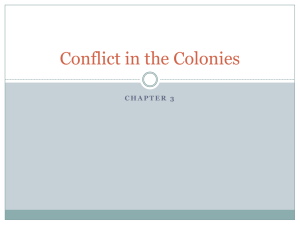American Revolution
advertisement
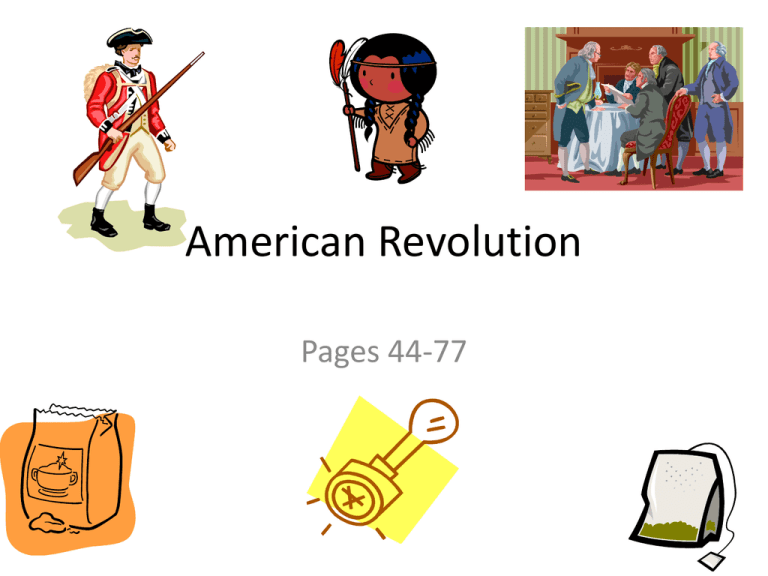
American Revolution Pages 44-77 American Revolution Quote page 44 Translate the following quote: You will need to recite this quote on Friday, October 8th “ I know not what course others may take, but as for me, give me liberty or give me death.” - Patrick Henry Revolutionary Vocabulary page 46 Word Definition Writs of Assistance Legal document that allowed the British officials to inspect ships without giving a reason Petition Formal written request to someone in authority signed by a group of people Boycott Refuse to buy or use certain products, goods or services Unite Join together Debt Money owed Tax Money added to cost of an item to support the government Copy the following vocabulary words along with definitions and sketch a visual representation of the definition Sketch Word Revolutionary Vocabulary page 47 Copy the following vocabulary words along with definitions and sketch a visual representation of the definition Definition Committees of Letters of correspondence protest in the colonies Massacre Unnecessary killing of a large number of people Port A place where ships load or unload cargo Delegate A person picked to represent Patriot Colonist who wanted to go to war with Britain Loyalist Colonist who wanted to stay with Britain. Sketch North American Map before and after Treaty of Paris Page 48 Create a key and color the map appropriately French and Indian War Page 49 Answer the following questions 1. 2. 3. 4. 5. 6. 7. 8. 9. Who fought in the war? What were they fighting over? What side were the colonies on? Who wrote the Albany Plan and what did it suggest? What role did George Washington play? Who won the war? What happened to France? What ended the war? What were the results/significance of the war? 1. 2. Answers to page 49 3. Fill in the correct answers 4. 5. 6. 7. 8. 9. Who fought in the war? the French and Indians versus the British and colonists What were they fighting over? Ohio River Valley What side were the colonies on? The Britain/English because Britain is their mother country Who wrote the Albany Plan and what did it suggest? Ben Franklin wanted the colonists to unite with Britain against the French and Indians What role did George Washington play? War Hero Who won the war? Britain What happened to France? France lost the war and the race for dominance in North America What ended the war? Treaty of Paris 1763 What were the results/significance of the war? France is out of North America. Britain does not have to compete with France any more. England has a huge war debt. Britain feels the colonists should pay the debt Join or Die Cartoon Page 50 Answer the following questions about America’s first political cartoon: 1. What do you think the letters stand for? 2. Why is the snake cut into sections? 3. Why are the words “Join or Die” written below the snake? Franklin’s campaign for Unity Worksheet/ Chapter 11 Worksheet Page 51 Franklin’s campaign for Unity Worksheet/ Chapter 11 Worksheet Page 52 Answers page 52 Answers to worksheet over chapter 11 1. Believed they were not grown up and capable of taking care of themselves 2. Believed they had been running their own affairs since they arrived. 3. Risked lives and gone through hardships, built homes and farms in a land of thick forests 4. Prideful, not wise, 5. By sponsoring taxes they thought were unfair. 6. Budget; foreign wars had left England with big bills 7. No colonist served in Parliament; therefore, no colonist got to vote. 8. Printed paper 9. Angry – tarred and feathered tax collectors 10. Lead, glass, paper, paint, and tea 11. Boycott: demanded repeal of tax 12. Tea 13. Boston Tea Party 14. ½ Boston citizens out of work; this united all the colonies 15. Sent supplies, money, rice, sheep and prayers. Taxation without Representation Notes page 53 Copy notes on page 53 • King and Parliament wanted the colonists to pay taxes to cover the cost of the debts from the French and Indian War • Taxes were passed in Parliament without the vote of the colonists or the approval of the colonists • Some colonists got angry about the amount of the taxes and the items that were taxed • Most colonists paid the taxes because the choice was debtors prison • Tax collectors were the most hated because they were the ones collecting the taxes and they were in the colonies • People were angry that England was getting all the benefits. Patriot vs. Loyalists POV page 54 Read the notes on page 55 and decide how a loyalist would feel about the events and how a patriot would feel about the events. Event Patriot POV Loyalist POV Proclamation of 1763 Unfair, we fought for land why are they giving it to those we fought, Tyranny King is trying to avoid conflict, protect us and help the economy Stamp Act Taxes without a vote Pay off the debt and help our economy Quartering Act We don’t want in the colonies and we sure don’t want them in our homes They are providing security Townshend Act Unfair, we shouldn’t have to pay for items we need Yeah, let’s pay off our debts. This is helping our economy Boycotts Great, maybe this will stop the taxes Hate it, we are losing money French and Indian War Road to Revolution page 55 Copy the notes on page 55 Proclamation of 1763 King makes a law telling colonists that they cannot settle west of the Appalachian Mountains. This law was passed to prevent conflict between the colonist and Indians Stamp Act (Taxation without Representation) In order to pay off the debt from the French and Indian War, Britain decided to tax the colonists more. The Stamp Act required all people to buy a stamp for any piece of paper they used (newspapers, cards, licenses, etc.). Quartering Act Colonists would have to provide British soldiers a place to live and the basic needs for the soldiers. Townshend Acts Britain put a tax on imported goods from Britain like glass, paper, and tea. Taxes were needed to pay off debts. Colonists Boycott A non violent way to protest the taxes Patriot vs. Loyalists POV page 56 Read the notes on page 57 and decide how a loyalist would feel about the events and how a patriot would feel about the events. Event Patriot POV Loyalist POV Boston Massacre Used it as propaganda to turn people against Britain & the soldiers If you can’t play with the big dogs, don’t get off the porch Tea Act Angry, taxation w/out representation Prices are rising Debt needs to be paid off. They repealed everything else. Boston Tea Party We will show them what we think of the Tea Act You can’t destroy property because you don’t like the rules. Intolerable Acts Punishment is too harsh We are being punished for the Patriots bad behavior First Continental Congress Yeah, finally the colonies are uniting against the King Boo, now they are uniting and speaking for everyone Lexington and Concord Finally, independence is near OMG, we don’t want independence Boston Massacre Road to Revolution page 57 Copy the notes on page 57 A riot in Boston led to the death of 5 colonists. British soldiers were in Boston and the colonists were making fun of the soldiers. Colonists also threw snowballs and rocks at the soldiers. A soldier was knocked down in the riot and the soldiers fired on the colonists killing 5. Tea Act Britain forced a monopoly on tea. Colonists were only allowed to buy tea from the British East India Company. Because there was only one company to buy from, the price could be set at anything. Boston Tea Party Sons of Liberty went onto a ship in the Boston Harbor and threw all the tea into the water (example of Civil Disobedience: nonviolent way to protest). This was the colonial reaction to the Tea Act. Intolerable Acts British reaction to the Boston Tea Party. The port of Boston will be closed to all imports and exports until the tea is paid for. More troops were also sent to Boston. This united all the colonists against Britain. First Continental Congress Leaders from 12 colonies met to decide what to do about the Intolerable Acts. Lexington and Concord British troops fire on militia men in Lexington and then in Concord firing the first shots of the American Revolution. This proved that the colonists would fight for freedom. Top Half Page 58 Parts – 5 things (parts) you see in the picture. No inferences, just what you see. You must be able to put your finger on the item specifically Analyze – Look at each part, what do you think that particular part of the picture represents or why is it there? Title – What do you think would be a good title for this picture? History – How does this picture relate to what you have talked about in class or what you know about History. Bottom Half Page 58 Parts – 5 things (parts) you see in the picture. No inferences, just what you see. You must be able to put your finger on the item specifically Analyze – Look at each part, what do you think that particular part of the picture represents or why is it there? Title – What do you think would be a good title for this picture? History – How does this picture relate to what you have talked about in class or what you know about History. Section 5.2 BEFORE 1763 Metaphors page 59 Read each metaphor, then read the stated section in your History Alive textbook. Try to match Historical events to the Metaphors Metaphors Historical Event Students are happily playing basketball in the gym. There are no adult, just students. Colonists are left to govern themselves with no interference from Britain The principal’s office is far away from the gym. Government (king) is far away from the colonies Section 5.3 EARLY BRITISH ACTION All the sudden, there are new rules for the gym. New King – King George imposes new rules on the colonies The students may only use half the court. They can see that it is available, but the students are no allowed to use it. Proclamation of 1763 – colonists can’t go past the Appalachians, remainder set aside for Native Americans Students will have to pay to use the gym & equipment Stamp Act – colonists have to pay extra for items they need The money collected from the students will pay for the supervisor to be in the gym at all times. Quartering Act – not only must colonists pay taxes; they must house and feed the soldiers The students are angry about having everything changed Colonists angry about new laws; show anger by boycotting and protesting Path page 60 Parts – 5 things (parts) you see in the picture. No inferences, just what you see. You must be able to put your finger on the item specifically Analyze – Look at each part, what do you think that particular part of the picture represents or why is it there? Title – What do you think would be a good title for this picture? History – How does this picture relate to what you have talked about in class or what you know about History. Section 5.4 TOWNSHEND ACT Metaphors page 61 Read each metaphor, then read the stated section in your History Alive textbook. Try to match Historical events to the Metaphors Metaphors Historical Event A man is now standing at the counter collecting money from the students for the use of the basketballs and the gym Charles Townshend is imposing taxes on every day items Townshend Act One student starts to tell the others not to use the basketballs that the students have to pay for. Boycotts of British goods. Women participate by sewing own cloth. Section 5.5 THE BOSTON MASSACRE Students are picketing the gym letting everyone know that the new rules are unfair Patriot mob antagonizes British troops Vice Principal and Security guard are protecting the gym British troops are sent to Boston The Vice Principal and Security tell them to stop or get suspended British Troops fire on the unruly crowd. Top Half page 62 Parts – 5 things (parts) you see in the picture. No inferences, just what you see. You must be able to put your finger on the item specifically Analyze – Look at each part, what do you think that particular part of the picture represents or why is it there? Title – What do you think would be a good title for this picture? History – How does this picture relate to what you have talked about in class or what you know about History. Bottom Half Page 62 Parts – 5 things (parts) you see in the picture. No inferences, just what you see. You must be able to put your finger on the item specifically Analyze – Look at each part, what do you think that particular part of the picture represents or why is it there? Title – What do you think would be a good title for this picture? History – How does this picture relate to what you have talked about in class or what you know about History. Section 5.6 TEA ACT Metaphors Metaphors page 63 Read each metaphor, then read the stated section in your History Alive textbook. Try to match Historical events to the Metaphors Historical Event There are new rules in the cafeteria. Students may only eat cafeteria food. No one can bring food in or out Colonists are forced to buy tea from East India Company Students throw the food into the trash cans Sons of Liberty dump tea into the harbor Other students cheer for the ones throwing the food out Celebration of the “Tea Party” Section 5.7 THE INTOLERABLE ACTS All the students in the cafeteria are given Saturday detention Boston Harbor is closed down until the tea is paid for. These are harsh laws Some students were not involved in the throwing the food away and did not think it was a good idea Loyalists thinking the Bostonians have gone too far Students from other schools write protest letters to show the rule is not fair Letters to King George from the 1st Continental Congress 5.8 LEXINGTON AND CONCORD STUDENTS ARE STILL ANGRY AND PROTESTING THE CAFETERIA The principal sees that detention does not work. King George sees that he can’t break the colonists. Principal wants stronger action taken, more punishment Britain considers stronger actions A student overhears the principal saying he wants more action and runs off to warn other students Paul Revere and William Dawes warn the colonists. Reasons for Choosing sides in the American Revolution Page 64 Loyalists Patriots 1. We would lose our land and our protection 2. We owe our allegiance to England (our mother country) 3. We would all be guilty of treason 4. We cannot fight against the strongest army and navy in the world and win 5. We have no supplies or soldiers to fight 6. Our businesses would fail if we did not have England to sell our stuff for us. 1. England and the colonies are too far apart for the protection we need. 2. King and Parliament have taken away our rights and do not deserve our allegiance. 3. Nothing worth doing is easy. 4. We have the desire and the passion to win. 5. We will do with what we have and get help from other nations. 6. We can control our businesses and freely trade making our own money Who’s Who page 65 Use your History Alive textbook to complete the worksheet Most Important Figure page 66 Choose one of the “People of the Revolution” who you believe is the most important person to the Revolution and justify your choice. It should be at least 5 sentences • I believe John Adams is the most important revolutionary figure because ……… Who’s Who page 67 Use your History Alive textbook to complete the worksheet Picket Signs page 68 Divide the page in half. On the top half: draw a picket sign for a PATRIOT trying to convince a colonist to fight against Britain On the bottom half: draw a picket sign for a LOYALIST trying to convince a colonist to remain loyal to the king. Events that 1. led to Independence Part I 2. Page 69 3. 4. 5. 6. 7. Paul Revere and others warn the colonists that the British are coming, look for the lantern in the window – one if by land, two if by sea Lexington and Concord – First shots of the American Revolution. Americans send the British back at Concord motivating the colonists to fight. Battle of Bunker Hill actually on Bred’s Hill. Americans fought bravely and killed a lot of British soldiers, but ran out of supplies and had to retreat. Even though they lost, the Americans got a great sense of pride. Second Continental Congress – John Hancock was president. All the colonies except Georgia met to decide what to do. They appointed George Washington as head of the Continental Army and try to make peace with King George Olive Branch Petition – Last effort to get King George to give the colonies their rights to representation and lower the taxes. THE KING SAYS NO!!!! Thomas Paine writes Common Sense that motivates the common man to be involved in and support the war against Britain Second Continental Congress decides to write a document that tells why they are fighting. Declaration of Independence Page 70 Recite Highlighted area on: Declaration of Independence Declaration of Independence Page 71 written by Thomas Jefferson Adopted on July 4, 1776 John Hancock was president of the Continental Congress, so he signed first and the largest The DOI is based on the theories of John Locke – people have basic rights the government cannot take away. If the government disregards rights, they lost the right to govern. “The People” – Rich, white men only Declaring independence was an act of treason (crime against the government) – If they lose the war, they will be hanged. – They were willing to give up everything for freedom The DOI is a list of grievances (complaints) against King George and an explanation for the need for independence Revolution Acrostic page 72 Create an Acrostic Poem about The American Revolution using your notes on page 73 • R is for • E is for • V is for Valley Forge where The Crisis was read to the troops • • • • • • • O is for L is for U is for T is for I is for O is for N is for 1. Completion of Independence, American Revolution part II 2. Page 73 3. 4. 5. 6. 7. Once independence is declared, the Colonies must fight to win independence. England will not just give it to them. Many more people are motivated to fight now that independence is the goal. Many African Americans joined the fight hoping it would lead to the end of slavery There has to be a government so the Second Continental Congress sets up the Articles of Confederation as the first government to run things until they can figure it out. George Washington reads The Crisis to his troops at Valley Forge to motivate them to keep fighting. The harder it seems, the more you need to fight. Washington starts fighting only on the defensive to tire out the British SARATOGA – a turning point in the war. This victory convinces France that the Americans have a chance to win. The French send troops and money to help. YORKTOWN – last battle of the Revolution. British surrender after being surrounded by the French and Americans. Treaty of Paris 1783 – Ended the war and gave Americans land and their independence Sketch of Weaknesses and Strengths page 74 AMERICAN STRENGTHS WEAKNESSES Sketch America’s weaknesses and strengths and sketch Britain’s strengths and weaknesses BRITISH STRENGTHS WEAKNESSES 1. Patriotism 2. French Help 3. Good Leadership (George Washington) 1. Lots of soldiers 2. Best army and navy in the world 3. Well supplied Weaknesses Page 75 British strengths Who wins the American Revolution Americans 1. Not enough soldiers 1. Britain is too far 2. Shortage of supplies away (it takes a 3. Poorly trained and long time to send unprepared men and supplies) 2. Poor leadership The Treaty of Paris brings America the independence they wanted, but leaves them with a huge debt that needs to be paid off. The Americans will have to prove themselves to every other country while trying to get themselves organized. Timeline Events Page 77 Event Date Details Lexington and Concord April 1775 1st battle of American Revolution Appointment of George Washington May 1775 GW was appointed commander of American troops Battle of Bunker Hill June 1775 Americans lose but get a sense of pride Common Sense January 1776 Motivated many ordinary people to support independence Declaration of Independence July 4, 1776 Declares that colonies need to be separate from King George II and Great Britain The Crisis Fall 1776 (Sept –Dec) “These are the times that try men’s souls” – motivates many to stick with the cause Saratoga October 1777 Turning point convinces France to support Americans Articles of Confederation November 1777 1st government for Colonies Valley Forge Winter 1777-78 (Dec – Mar) Washington’s winter camp where many men suffer from the cold. Washington motivates many to keep fighting Yorktown October 1783 British surrender the final battle of the American Revolution Treaty of Paris 1783 September 1783 Official end to war and recognition of independence
